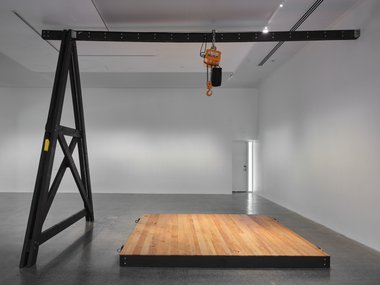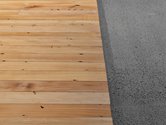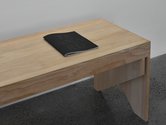John Hurrell – 25 May, 2021
The exhibition in the gallery is also highly speculative, as a kind of imaginative riff on hoists and winching; a sort of minimalist graphic diagram in anticipation of vectors. The inverted black vee is visually dramatic as a steel strutted sculpture with the adjacent planked platform emitting barely audible 'cave' rumblings from below.
Titirangi
Jenny Gillam and Eugene Hansen
The Thrum of the Tide
20 February - 6 June 2021
Jenny Gillam and Eugene Hansen, two Wellington-based artists who teach at Massey, were the recipients of the 2019 Auckland Regional Parks Artist Residency, and in their research along the west Whatipu coast they heard about Te Ana Ru, a sea cave used by early European settlers for Saturday night dances up until the 1920s. Apparently there was a repurposed kauri floor (built in the early 1900s by mill workers who recycled wood from the cookhouse) that after each dance was hoisted up to the ceiling to protect it from high tides.
Te Ana Ru, the softcover publication that accompanies this exhibition, details the artists’ search for that original dancing platform, now possibly buried in the cave, while the Te Uru display presents a ‘reconstructed’ ballroom floor in the gallery (guessing at the dimensions)—alongside a mechanical hoist attached to a metal A-frame.
In the informative 52 page booklet that is rich in b/w documentary photographs, there are two quite different essays; one by Gillam, the other by Hansen. Gilliam deals very thoroughly with the known history of the cave and its location, and how the settlers used the enclosure socially for musical entertainment. Hansen deals on the other hand in detail with their efforts to search for the remains of the wooden floor by drilling through the wet sand at likely locations, and noting when they hit something solid.
Staying in the cave overnight, Hansen methodically made a series of recordings of microsonic vibrations from deep in the cave’s bed, which he later amplified and speeded up. These he has treated as summoned voices, much like say William Burroughs with his writing experiments transcribing recorded traffic noises as speaking texts (1), or paraconceptualist Susan Hiller with her use of Konstantīns Raudive who left tape machines running in soundproof rooms and believed he was recording the voices of the dead.
For a large part of his text, Hansen takes the cavebed sonic recordings and processes the data through four hybrid GPT-2 AI programmes that ‘converse’: Windup AI; Subliminal AI; Normal AI; and She, The Other AI. The different systems select language phrases and organise word sequencing, but one gets the feeling they (as a collective method of transmuting a grid of figures into ‘voices’) are more fun to make than to actually read.
The Thrum of the Tide, the exhibition in the gallery is also highly speculative, being a kind of imaginative riff on hoists and winching; a sort of minimalist graphic diagram in anticipation of vectors. The inverted black vee is visually dramatic as a steel strutted sculpture with the adjacent planked platform emitting barely audible ‘cave’ rumblings from below, and some taonga pūoro music.
Gillam and Hansen’s project reminds me of Maddie Leach’s 2014 Walters Prize entry, If You Find the Good Oil Let Us Know, in that it attempts to turn a failed search into an engrossing visual statement—in Leach’s case a beautiful little red book published by the Govett-Brewster. For Te Uru, the bones of a thwarted investigative narrative are imaginatively used by the residency artists to construct two essays and a gallery display.
Both Gillam/Hansen and Leach have had brilliantly successful projects in the past, but these particular works are examples where a driving idea has come to a dead end, but the artists don’t want to let go because of all the work they’ve invested. The problem is that the searching process is not sufficiently interesting in itself, with the underpinning notion for a presentation ending up being far too subtle for an audience to attend to it for long.
However I think here that the Te Ana Ru book is better than Gillam and Hansen’s exhibition of related sculpture—albeit visually dramatic—despite both being fanciful (it is hard to imagine a pristine public art gallery as a cave). Even though Hansen’s text (I reckon) doesn’t work as an integrated piece of writing, both essays are interesting, for Gillam is a skilled communicator about settler history, and Hansen very amusing in the way he describes his interactions with the nosey public while he was recording. Buy the publication.
John Hurrell
(1) See William S. Burroughs, ‘The Invisible Generation’, in The Ticket That Exploded, p. 181, Corgi, 1971.















 Advertising in this column
Advertising in this column Two Rooms presents a program of residencies and projects
Two Rooms presents a program of residencies and projects



This Discussion has 0 comments.
Comment
Participate
Register to Participate.
Sign in
Sign in to an existing account.